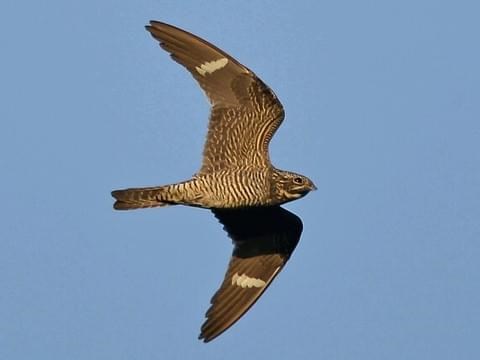The spring migration season came to a conclusion on May 30 when our last regular migrant species, common nighthawk, was reported by three separate observers: Lee Ann Ennis and Rand Rudland in Halfmoon Bay, and John Field in Pender Harbour.
Nighthawks always appear on the Sunshine Coast in the last few days of May or the first few days of June, with an earliest ever arrival date of May 27. They have one of the longest migrations of any North American bird with many wintering in Argentina. They occur all over North America in the breeding season including north of 60 in southern Yukon. The birds begin their northward migration in late February and some only arrive on the breeding ground in mid-June. As part of the aerial insectivore group of birds, they are reliant on a reliable source of flying insects for their food requirements and this explains their late arrival in northern climes.
On the Sunshine Coast nighthawks are most often seen flying erratically overhead in loose flocks on warm summer evenings. This is after the conclusion of their nesting season. They also attract attention with the “booming” or whistling noise made by their feathers as they swoop after insects. Two white bars are also very visible on their wings. Nighthawks are crepuscular (most active at dawn and dusk) when they indulge in a burst of feeding activity, and their peak vocalization is 30 to 45 minutes after sunset. They nest at all elevations on the Sunshine Coast from open, rocky areas at sea level to regenerating clearcuts in the mountains. When perched on the ground or on a tree branch, they are almost impossible to see with their cryptic colouration. They do not build a nest but lay their eggs directly into a barely visible scrape in the gravel on the ground.
I have frequently referred to the evening song of Swainson’s thrush as “the sound of summer on the Sunshine Coast.” For the last two to three weeks, they have been in full voice on the beautiful, still evenings and it is heartening how common they are. The robins have also been singing up a storm!
On May 26, Karen Holland located and photographed a western kingbird on a fencepost in west Porpoise Bay. Kingbirds, both the eastern and western species, are uncommon migrants on the Sunshine Coast with usually only one or two reports per year. They are abundant in the Okanagan. A couple of correspondents have sent photos of an odd-looking leucistic robin on Lee Bay Road in Pender Harbour. Leucism is the absence of pigment in the feathers and produces a blotchy, largely white plumage.
To report your sightings or questions contact tony@whiskeyjacknaturetours or 604-885-5539. Good birding.



